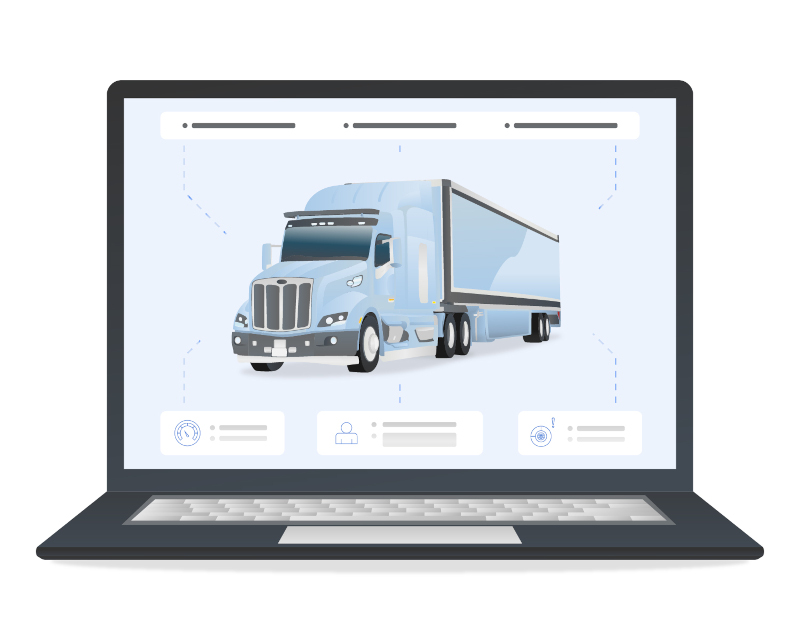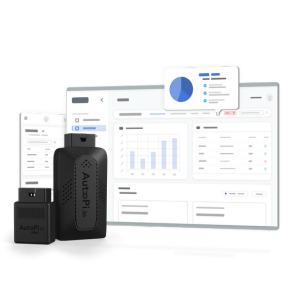A delivery van that idles ten minutes a day burns an extra 450 litres of diesel a year.
Multiply that by 200 vehicles and you have a six-figure fuel leak, before tyres, brakes, or fines enter the equation.
Fleet management turns those leaks into line-item savings with GPS, telematics, and data you can act on by lunchtime.
It is the system that schedules repairs before a breakdown, reroutes trucks around gridlock, and proves every safety check to regulators.
Master the fundamentals and your trucks, drivers, and balance sheet all run leaner, safer, and farther.
What is Fleet Management?
Fleet management is the process of overseeing, organizing, and coordinating a fleet of vehicles to improve efficiency, reduce costs, and ensure compliance with regulations.
Whether it’s a delivery service with a dozen vans or a large corporation with hundreds of trucks, effective fleet management is crucial for smooth operations.
At its core, fleet management involves tracking vehicle performance, scheduling maintenance, monitoring driver behaviour, and optimizing routes. By leveraging technology and data, fleet managers can make informed decisions that enhance productivity and safety.
Quick Facts About Fleet Management:
-
Cost Savings: Effective fleet management can reduce fuel consumption by up to 20%.
-
Safety: Fleet management systems can lower accident rates by monitoring and improving driver behavior.
-
Efficiency: Optimized routing can decrease travel time and improve delivery schedules.
-
Compliance: Ensures adherence to regulations, avoiding costly fines and penalties.
-
Data Utilization: Modern fleet management relies heavily on data analytics for decision-making.
Imagine you have a fleet of delivery trucks. With effective fleet management, you can ensure each vehicle is serviced on time, routes are optimized to save fuel, and drivers adhere to safety standards. This not only saves money but also enhances customer satisfaction.

What Does a Fleet Manager Do?
A fleet manager is the backbone of any fleet operation. They ensure that everything runs smoothly, from vehicle maintenance to driver safety and everything in between.
Here’s a closer look at the key roles and responsibilities of a fleet manager:
Roles and Responsibilities:
-
Vehicle Maintenance and Repairs:
-
Scheduling regular maintenance to prevent breakdowns and extend the lifespan of vehicles.
-
Coordinating repairs promptly to minimize downtime.
-
-
Driver Management:
-
Hiring, training, and supervising drivers.
-
Monitoring driver behavior to ensure safety and compliance with regulations.
-
-
Cost Management:
-
Keeping track of expenses related to fuel, maintenance, and repairs.
-
Implementing strategies to reduce costs, such as optimizing routes and improving fuel efficiency.
-
-
Compliance and Safety:
-
Ensuring all vehicles and drivers comply with local, state, and federal regulations.
-
Maintaining accurate records of inspections, permits, and licenses.
-
-
Route Planning and Optimization:
-
Using GPS and telematics systems to plan efficient routes.
-
Adjusting routes in real-time to avoid traffic and reduce fuel consumption.
-
-
Data Analysis and Reporting:
-
Analyzing data from fleet management software to identify trends and areas for improvement.
-
Preparing reports for upper management on fleet performance and cost savings.
-
Skills Required:
-
Organizational Skills: Ability to manage multiple tasks and keep detailed records.
-
Problem-Solving Skills: Quick thinking to resolve issues like vehicle breakdowns or route changes.
-
Communication Skills: Effective communication with drivers, suppliers, and upper management.
-
Technical Skills: Proficiency with fleet management software and telematics systems.
-
Analytical Skills: Ability to analyze data and make data-driven decisions.

Being a fleet manager is a demanding role, but with the right skills and tools, it can be incredibly rewarding. Effective fleet management not only improves operational efficiency but also contributes to the overall success of the business.
Benefits of Fleet Management
Effective fleet management depends on consistent, high-quality data from vehicles and assets. By aligning preventive
maintenance with condition data and fault histories, operators reduce unplanned downtime and extend service intervals.
GNSS and telemetry support route optimisation, utilisation analysis, and trip segmentation, allowing fleets to
identify idle time, inefficient routes, and assets operating outside expected thresholds.
Fuel and energy metrics gathered from the vehicle network enable precise monitoring of consumption, charging patterns,
and load conditions. Driver-behaviour signals such as acceleration, braking, and speed deviations provide objective
inputs for safety policies and training. These datasets improve regulatory compliance by maintaining auditable logs
for inspections and incident reviews.
Maintenance records, diagnostic events, and lifecycle data help identify high-cost or end-of-life assets, supporting
evidence-based replacement planning. Real-time visibility into vehicle status and location improves dispatching,
ETA accuracy, and service reliability. As fleets adopt EVs, the same telemetry framework extends to battery state,
charging performance, and range modelling, ensuring continuity across mixed powertrains.
Combined, these capabilities reduce operational overhead, improve safety, and support a measurable reduction in total
cost of ownership across ICE and EV fleets.

By understanding and leveraging these benefits, you can significantly enhance the performance and efficiency of your fleet operations.
Challenges Faced by Fleet Managers
Fleet managers juggle a complex mix of challenges, from keeping vehicles road-worthy and minimising downtime to
addressing driver shortages and rising fuel costs. Scheduled preventive maintenance, reinforced by predictive
analytics, curbs unexpected breakdowns, while competitive pay, benefits and continuous training help attract and
retain skilled drivers. Fuel is a dominant budget line, so disciplined fuel-management programmes and eco-driving
coaching are essential. Regulatory demands shift frequently, and penalties for lapses can be severe, making cloud
tools such as AutoPi Cloud invaluable for staying audit-ready.
Safety sits alongside compliance, driver-behaviour monitoring and formal safety initiatives lower accident rates, insurance claims and lost
hours. At the same time, torrents of telematics data can overwhelm staff unless strong analytics highlight actionable
insights, and integrating new hardware like the AutoPi CAN-FD Pro with existing platforms relies on open APIs and
experienced vendors. Finally, smart routing, fuel cards and cross-system compatibility allow fleets to improve
service levels while keeping costs under control.
How Does Fleet Management Work?
Fleet management looks complex at first glance, but the discipline boils down to a set of repeatable processes driven by data and automation. Start by understanding the core workflows and the enabling technologies; once these pieces are clear, optimising cost, safety and uptime becomes a structured exercise rather than guesswork.
Processes Involved
Day-to-day fleet operations revolve around four foundational processes. Vehicle acquisition defines fleet capability and TCO from the outset; maintenance keeps assets road-worthy; driver management ensures safe, compliant operation; and route optimisation turns real-time traffic data into predictable service levels. The table summarises each process and the outcome it targets.
| Process | Description |
|---|---|
| Vehicle Acquisition | Choosing the right vehicles that meet the specific needs of your operation. |
| Maintenance | Regular check-ups, servicing, and repairs to minimize downtime and breakdowns. |
| Driver Management | Hiring, training, and monitoring drivers to ensure safety and efficiency. |
| Route Planning and Optimization | Using GPS and telematics to plan efficient routes and make real-time adjustments. |
Technologies Used
Modern fleets rely on an ecosystem of connected devices and software. Telematics hardware streams location, CAN-based diagnostics and driver-behaviour metrics; fleet-management platforms consolidate that data with maintenance schedules and compliance logs; fuel-management modules track every litre; and predictive-maintenance analytics flag faults before they become roadside events. The matrix below maps each technology to the business function it unlocks.
| Technology | Function |
|---|---|
| Telematics Systems | Provides real-time data on vehicle location, speed, and driver behavior. |
| Fleet Management Software | Integrates maintenance scheduling, fuel management, compliance tracking, and data analysis. |
| Fuel Management Systems | Monitors and controls fuel consumption to identify inefficiencies and save costs. |
| Predictive Maintenance Tools | Uses telematics data to predict maintenance needs, preventing breakdowns and extending vehicle life. |
Example: Process + Technology in Action
Bringing these processes and tools together delivers measurable results. The simplified case below tracks a parcel carrier that combined predictive maintenance, GPS routing and a structured driver programme. Note how each challenge maps to a specific technology stack and the quantifiable benefit that followed.
| Challenge | Solution Implemented | Result |
|---|---|---|
| Frequent vehicle breakdowns disrupting operations. | Implemented fleet management software integrating telematics and predictive maintenance tools. | Reduced breakdowns by 30% and saved on repairs. |
| Inefficient route planning causing delays and high fuel costs. | Used GPS and telematics systems to optimize routes and make real-time adjustments. | Reduced delivery times by 20% and cut fuel costs by 15%. |
| High driver turnover affecting operational stability. | Developed a comprehensive driver management program including training and competitive benefits. | Improved driver retention by 25% and enhanced overall efficiency. |
Fleet management is a dynamic and multifaceted field. By understanding and effectively implementing these processes and technologies, you can transform your fleet operations. From vehicle acquisition to real-time route optimization, each piece plays a vital role in creating a seamless and efficient system.
How to Improve Fleet Management
Effective fleet management hinges on a closed-loop cycle of preventive maintenance, data-driven routing, rigorous
driver training, and vigilant cost control. Begin by aligning service intervals with OEM guidelines and augmenting
them with predictive diagnostics to catch faults before they cause downtime. Pair GPS-enabled route optimisation and
live traffic feeds to cut fuel burn and guarantee on-time deliveries, while recurring driver-coaching sessions
reinforce eco-driving, safety protocols, and regulatory compliance.
Fuel-management tools that log consumption, highlight idling, and promote steady-speed habits protect operating margins; wrapping these initiatives in a unified
fleet-management platform consolidates maintenance, fuel, telematics, and compliance data into a single source of
truth. Finally, sustain a culture of clear communication and continuous technology investment, leveraging telematics
for behaviour monitoring, analytics for trend detection, and automated rule tracking for evolving regulations, to keep
operations safe, efficient, and future-ready.

Improving fleet management is about adopting a proactive and strategic approach. By implementing these tips and continuously evaluating your operations, you can achieve greater efficiency, reduce costs, and ensure the smooth running of your fleet.
Fleet-Management Feature Matrix & Expected Pricing (per vehicle)
Feature sets and pricing vary sharply across vendors. The table compares a mainstream Core offer, a higher-tier Enhanced bundle, and the streamlined AutoPi Cloud stack. Use it to gauge which capabilities you need today, what they typically cost, and where AutoPi slots in when you want CAN FD data without paying enterprise rates.
|
Feature (typical cost) |
Core ≈ €12 / mo |
Enhanced ≈ €22 / mo |
AutoPi Cloud ≈ €6 / mo |
|---|---|---|---|
| Real-time GPS | 60 s refresh | 10 s refresh + API | 1 s refresh + API |
| Geofencing | Circles + e-mail | Nested polygons + SMS | Polygons + push/webhook |
| ELD / HOS | US rule set | US + CA, auto-update | Bring-your-own ELD (API hook) |
| Fuel / DEF Metrics | Daily totals | Trip charts + alerts | Trip charts + alerts |
| Preventive Maintenance | Odometer reminders | Hours + inventory link | Mileage + hour rules, API export |
| Diagnostics (DTC) | OBD-II freeze-frame | OBD-II + FD live | OBD-II + FD live |
| Driver Behaviour | Harsh events | Compliance + belt status | Harsh events |
| EV SOC & Range | - | Live SOC, kWh/100 km | Live SOC, charge status |
| OTA Firmware | - | Signed roll-outs | Signed roll-outs |
| API Access | Read-only REST | Read/write REST + MQTT | Read/write REST + MQTT |
Conclusion
Fleet management is a multifaceted and dynamic field that requires a strategic approach to ensure efficiency, safety, and cost-effectiveness. From understanding the fundamental processes and leveraging advanced technologies to addressing common challenges and implementing best practices, effective fleet management can transform your operations.
By focusing on preventive maintenance, optimizing routes, investing in driver training, monitoring fuel usage, and staying compliant with regulations, you can significantly improve the performance of your fleet. Utilizing data for continuous improvement and fostering good communication within your team are also key components of successful fleet management.
Remember, the journey to efficient fleet management is ongoing. It requires continuous evaluation and adaptation to new trends and technologies. By staying proactive and informed, you can navigate the complexities of fleet management and achieve your operational goals.
If you have any questions or need assistance with your fleet management, feel free to reach out to us. Our team of experts is here to help you get the best out of your fleet operations. Contact us today to learn more about how we can support you in optimizing your fleet.






